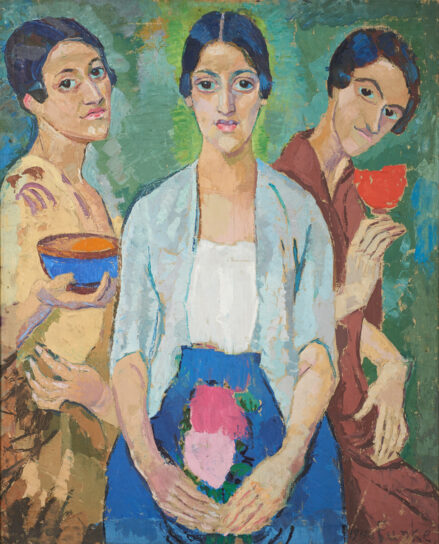Helene Funke, Three Women (originally Three Girls), 1915

Oil on canvas, 98 x 81 cm
Collection Lentos Art Museum Linz, Inv. Nr. 469
“Drei Frauen [Three Women]” features dark-haired girls holding in their hands different attributes – a purple bowl with orange glazing, a pink flower, a red chalice. The woman in the beige dress gives the impression of being proud and at the same time a little bored, as if she was aware – and fed up with – of our observant gaze. Her companion in a brown dress casts a concentrated and slightly dismissive glance over her shoulder. The woman in the middle focusses her magical eyes on us.
We know nothing about the identities of the three ladies nor do we even know for sure whether it is not the case that the three figures in fact represent one and the same person. Interestingly, the dark-haired slender women with large eyes resemble one another so that they may be regarded as three different aspects of one and the same personality. Perhaps Helene Funke, who was in close contact with painters in different countries, had chosen as a subject a colleague, the young painter and singer Ruth Wenger (1897 – 1994), who had been married to Hermann Hesse between 1924 and 1927 before she was succeeded by Funke’s friend Ninon, and was carrying on an affair with Karl Hofer at the same time? We know from a photo what the then 18-year-old singer and painter looked like. The physiognomic resemblance between the photo and the figure on the right in Funke’s 1915 painting is uncanny. This in any case is a woman who is totally self-possessed, keeps a watchful eye on her environment and presents the highest symbols of femininity and Christianity – bowl and chalice – with dignity and grace.
The artist addresses a pictorial theme which was prominent in Vienna at the time, the theme of the three ages, youth, maturity, and old age. The three women resemble one another and could be sisters, if they are not indeed one and the same person. Blooming youth, the adult woman with the bowl and the more mature woman with the chalice. Bowl and chalice are both maternal symbols associated with food, being symbolically representative of a woman’s breasts and womb.